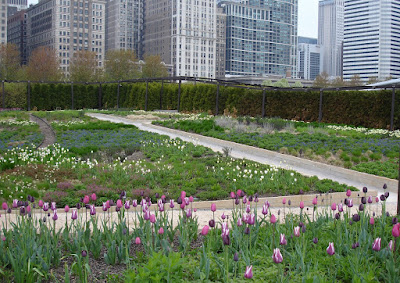 Guided Walks
Guided Walks in the Lurie Garden begin Sunday. Docents, most of whom are University of Illinois Extension Master Gardeners, will be on hand to give free 20-minute tours of the garden.
While all sizes of tulips in shades of bright fuscia, lipstick red, golden yellow, white and dark blue-violet continue to dominate attention from visitors and photographers, take a closer look at some of the more subtle flowers that are opening.

Between the Cloud Plaza and the yew hedge,
Fritillaria pallidiflora (Fritillary) is still blooming. This plant is a native to China and is used in the Lurie Garden for its hardiness and shape. It can withstand temperatures to -15F and its creamy yellow flowers mirror shape of tulip heads, gracefully nodding toward the ground. They brighten up and add texture to the Hosta 'Halcyon' whose leaves are at the height as the Fritillary.

Across the Plaza in the center of the Dark Plate,
Epimedium x versicolor 'Sulphureum' (Bishop's Hat) forms a groundcover at the Plaza's edge. Its flowers are a sulphur yellow (hence the name) and are so small that they may be overlooked. What is eye-catching about this plant is its foliage. Heart-shaped green leaves, edged in reddish bronze, form soft mounds about a foot high. As they mature, the leaves continue to redden, outlining the veins that remain green.
 Helleborus orientalis
Helleborus orientalis (Lenten Rose) opened in late April and will continue to flower through the month. The colors of this species vary from pale pink to deep violet. It is used in the garden for its early bloom time and because its foliage continues to look good throughout the year. In winter when patches of snow dot the garden, the leaves of the Lenten rose may be the only green in the garden.
Look for tour guides at the south end of the Seam, under the white awning.



